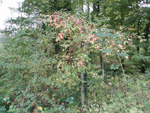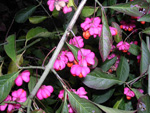Spindle Tree - An Autumnal Gem
Take a walk around the hedgerows in Meadow Park in October or November and, as likely as not your attention will be taken by a shrub that is truly outstanding in its natural beauty, even when compared to the glorious colours of this year’s fantastic Autumn. That will be Spindle, Euonymus europaeus, which, although I referred to it as a shrub, is just as often known as the Spindle tree. Both descriptions can be justified – solitary specimens will grow up to about twenty feet (about 6m) high with a definite trunk, but our hedgerow specimens do not normally attain more than about 10 feet (3m). The specimen in the picture was photographed at Basildon Park in late October 2007.
 The Spindle Tree has a preference for basic soils and is therefore commonly found on the chalk downs of Southern England. Fortunately, however, for the inhabitants of Earley it will also tolerate slightly acid soils – apart from those in Meadow Park there is at least one other example growing by the stream along the Green Path that runs from the Nature Reserve down to Gypsy Lane. The Spindle Tree has a preference for basic soils and is therefore commonly found on the chalk downs of Southern England. Fortunately, however, for the inhabitants of Earley it will also tolerate slightly acid soils – apart from those in Meadow Park there is at least one other example growing by the stream along the Green Path that runs from the Nature Reserve down to Gypsy Lane.
The tree derives its name from its hard, tough, smooth and splinter- resistant wood which was ideal for the making of spindles in the days when spinning was a common occupation, even before the spinning wheel had been invented. Apparently women twirled a stick between their fingers to draw out wool into thread, fixing circular stones with a central hole on to the end of the spindle to give it momentum. In the Summer months the tree may be easily spotted in a hedgerow by its conspicuous green twigs which tend to become squarish in cross-section as they become older, hence its French name of bois carré, “square wood”. Apparently it yields charcoal which is excellent for artists’ purposes. The leaves are on a short stalk, have a pointed tip and are very slightly toothed and at first sight look a bit like Privet. Throughout the summer they are an attractive mid-green but in Autumn assume a most beautiful hue, a mixture of purple, gold and crimson that look simply glorious in bright sunshine.
The flowers, which are borne in clusters, are inconspicuously small and white, often with a greenish tinge. Interestingly, spindle is one of those species that is either wholly male or wholly female so not all specimens will bear fruits. Each female flower produces seed pods with four lobes; green at first, these soon becomes a vivid shade of pink. Eventually the pod splits open to reveal the bright orange fruits which contrast starkly with the pink pods. The pink pods produce a red dye and the seeds a yellow one. The seeds are said to be poisonous to humans but not to birds.
 From what has been said earlier it will be apparent that in addition to its sheer attractiveness, the Spindle tree has had several uses in the past. In more recent years however it has been found to have another significant use in agriculture. The Black Bean Aphid, Aphis fabae, lays its minute eggs around the buds, in which stage they overwinter. In Summer however the aphids emerge and migrate on to any adjacent crops of Broad Beans, often badly damaging them unless the farmer uses an insecticide, an expensive business. Following much laboratory and field-based research, it was found that an accurate prediction of the scale of the outbreak in any particular area could be found by collecting samples of spindle twigs in the preceding winter and counting the numbers of eggs. The scientists could then advise the farmers whether or not it was likely to be necessary to spray their bean fields against the aphid, giving advantages both from the financial and environmental points of view. From what has been said earlier it will be apparent that in addition to its sheer attractiveness, the Spindle tree has had several uses in the past. In more recent years however it has been found to have another significant use in agriculture. The Black Bean Aphid, Aphis fabae, lays its minute eggs around the buds, in which stage they overwinter. In Summer however the aphids emerge and migrate on to any adjacent crops of Broad Beans, often badly damaging them unless the farmer uses an insecticide, an expensive business. Following much laboratory and field-based research, it was found that an accurate prediction of the scale of the outbreak in any particular area could be found by collecting samples of spindle twigs in the preceding winter and counting the numbers of eggs. The scientists could then advise the farmers whether or not it was likely to be necessary to spray their bean fields against the aphid, giving advantages both from the financial and environmental points of view.
Thanks to Alan for the details and pictures.
|